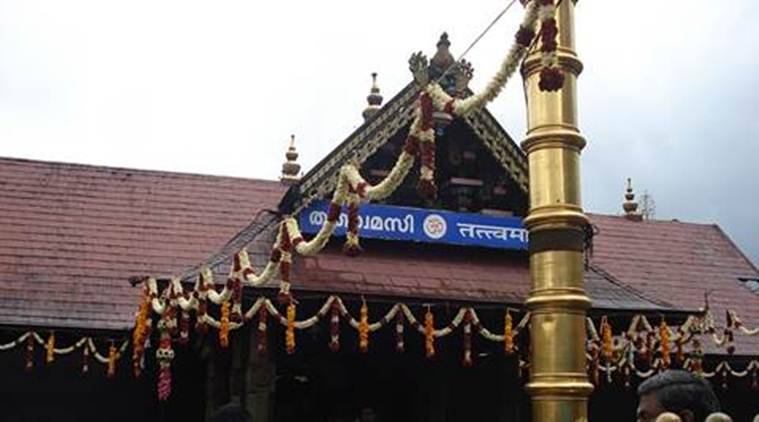 The temple opens for the first day of the Malayalam month of Thulam on Thursday. (File)
The temple opens for the first day of the Malayalam month of Thulam on Thursday. (File)
Ever since the Supreme Court of India delivered a landmark ruling last month lifting age restrictions for the entry of women at the popular Sabarimala temple in central Kerala, the raging issue has divided the state with supporters on either side. The last couple of weeks have seen a strong surge in street-protests and prayer meetings by devotees of Lord Ayyappa, the presiding deity at Sabarimala, with women participating in large numbers. This week, the subject is likely to reach a flashpoint when the temple opens for the first day of the Malayalam month of Thulam.
Here’s a primer on the temple, its significance in south India and how it makes powerful reverberations among the Hindus in Kerala.
The lore of Ayyappa
The myth of the presiding deity at Sabarimala is connected to the Pandalam royal dynasty which had settled in present-day parts of Pathanamthitta after breaking away from the Pandya dynasty. The King and Queen of Pandalam were believed to be childless. The story goes that when the King went hunting one day, he found a crying baby by the side of the river in a forest. Upon inquiring, a sage advised the king to take the baby home and bring him up as his own son, which the King eventually did. The child was named Manikandan and grew up to become the prince of Pandalam.
When Manikandan was 12, the queen of Pandalam developed a sudden illness and the physician treating the Queen recommended tigress’s milk to treat the same. While everyone shied away from the responsibility of bringing tigress’s milk from the forest, Manikandan volunteered to do so. He eventually not only brings the medicine, but himself rides a tigress, accompanied by several cubs, to return to the kingdom. The king, said to have been elated with his adopted son, realises that he is no ordinary child. According to the lore, Manikandan expresses his desire to renounce the kingdom and all material wealth and become an ascetic. The king later builds a shrine for his son, 30 kms away atop a hill that eventually became Sabarimala, where Manikantan acquires a divine form and becomes Ayyappan.
Location of the temple
The shrine of Lord Ayyappa is at present located atop a hill, 3000 metres above the sea level, at Sabarimala in Pathanamthitta district of Kerala. One has to trek upwards from Pamba, the base of the hill, to reach the temple. The temple is administered by the Travancore Devaswom Board, an autonomous authority under the state government which manages numerous other Hindu shrines in the state as well. The Thazhamon Madom is identified as the main family of priests who look after the temple.
Significance of the pilgrimage
Unlike other Hindu temples in the state, Sabarimala Sree Dharma Sastha temple is not open the year-round. It opens for devotees to offer prayers for the first five days of every month in the Malayalam calendar, as well as during the annual ‘mandalam’ and ‘makaravilakku’ festivals between mid-November to mid-January.
It is considered one of the biggest pilgrimages in the world, with millions of people offering prayers at the temple chiefly from the five south Indian states. Most of the pilgrims arrive at the temple during the busy ‘mandalam’ and ‘makaravilakku’ festivals, after they undertake a rigorous 41-day vratham, or a vow of abstinence. During this 41-day period, devotees are required to wear only black or deep blue attire, address each other as ‘swami’, perform daily pujas, abstain from non-vegetarian food, liquor and sex and not wear footwear. However, it is not mandatory for everyone to observe the ‘vratham’ to offer prayers at the temple. In 1991, following a High Court verdict, women of procreating age between 10 and 50 were barred from trekking to the temple. However, that HC verdict was overturned by the Supreme Court last week.
The temple’s secular credentials
The temple at Sabarimala is open to people of all religions. In fact, thousands of devotees who make their way to the temple make it a point to circumambulate a mosque dedicated to Vavar at Erumely. Different stories exist about the close friendship between Lord Ayyappa and Vavar, who is said to have been a warrior. There is also a shrine dedicated to Vavar close to the main temple complex at Sabarimala.
There is also a Christian connection to the temple. A large number of devotees also visit the Arthunkal church dedicated to St Andrew and St Sebastian at Alappuzha on their way to Sabarimala. At the church, many of them remove the sacred beads they wear around their neck through their 41-day fast. Ponds at the church are cleaned weeks before the annual pilgrimage begins.
‘Harivarasanam’, composed originally by KKS Iyer in Sanskrit, is recited mandatorily as a lullaby (urakkupattu) before the sanctum sanctorum closes for the evening every day. A modern and popular version of the composition by G Devarajan and sung by Dr KJ Yesudas is played these days when the temple doors are shut every night.